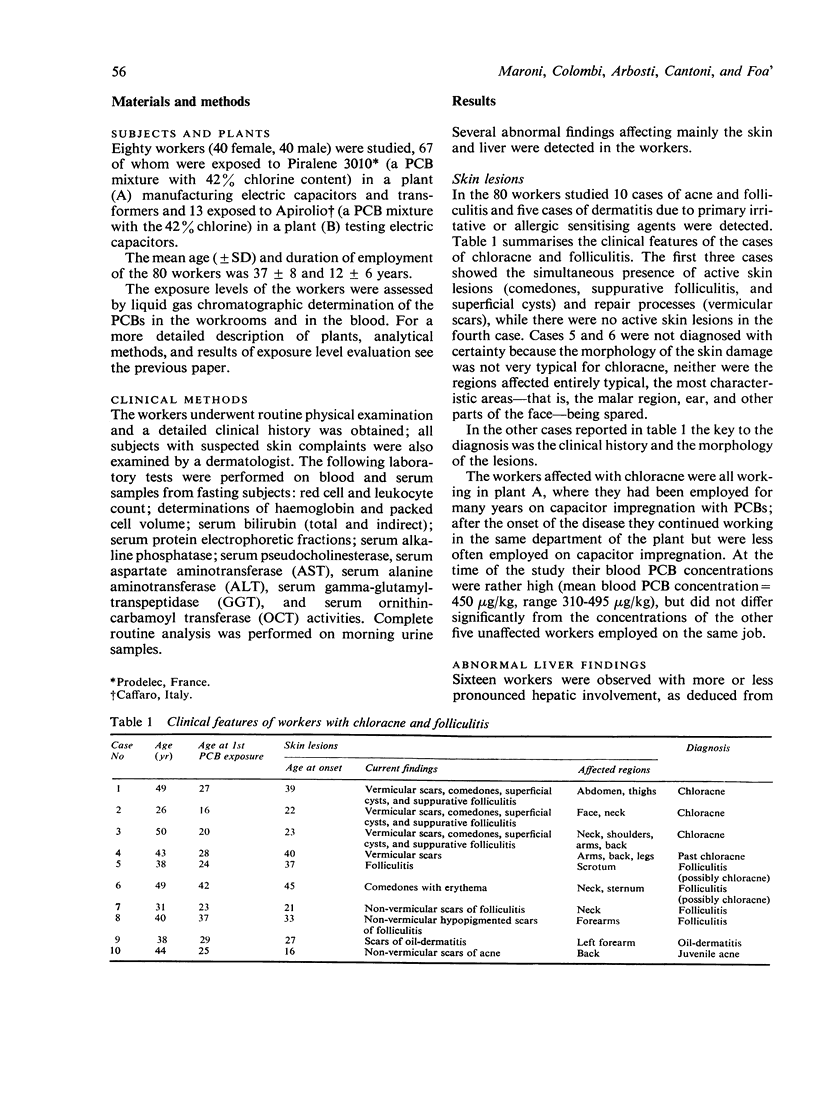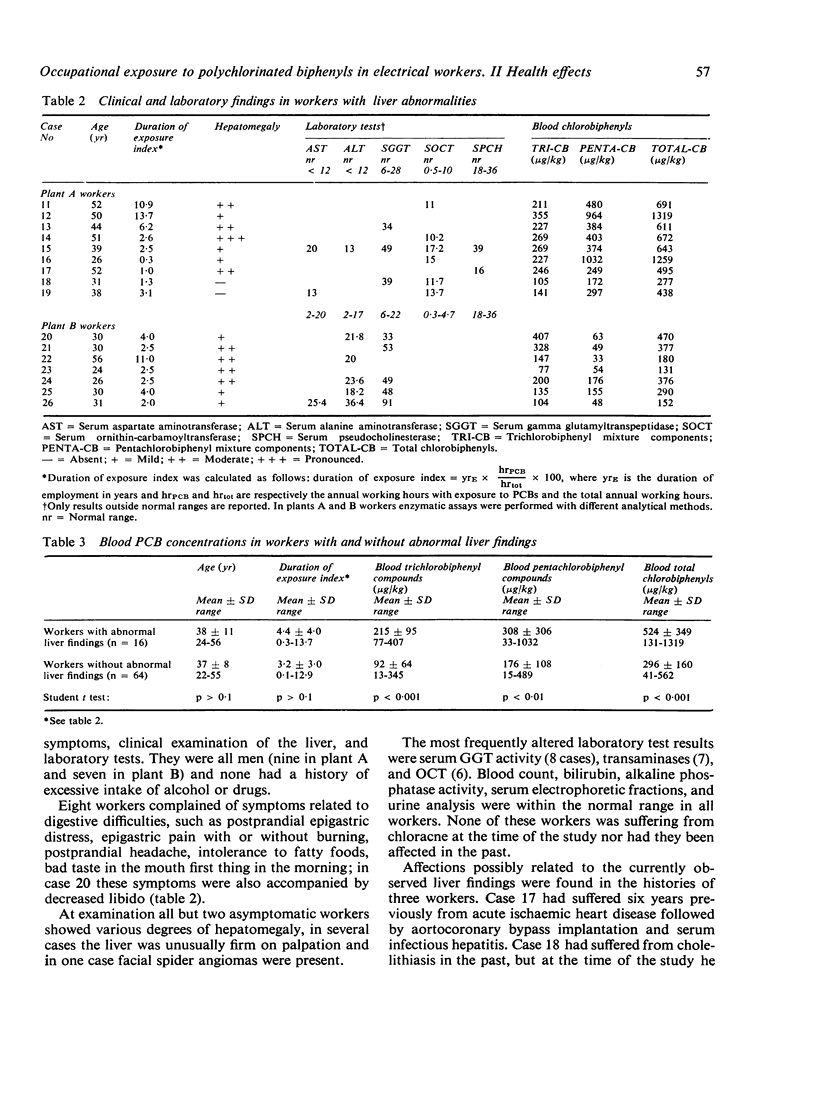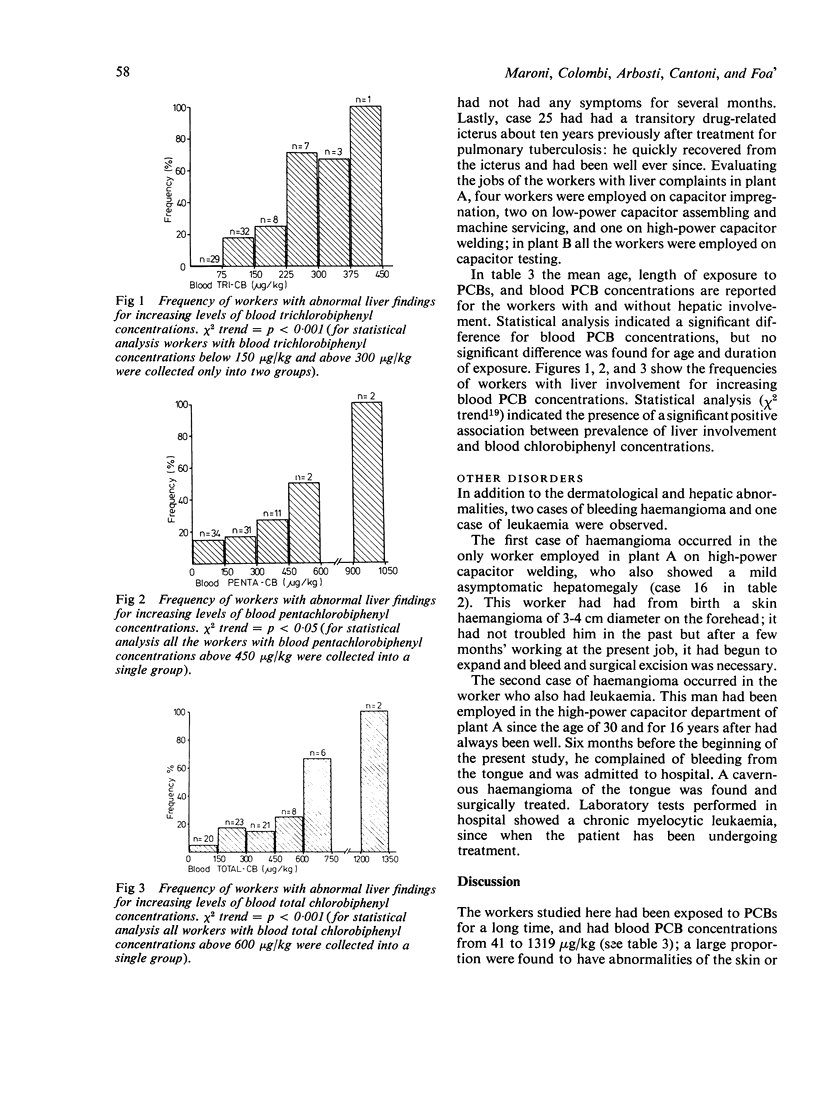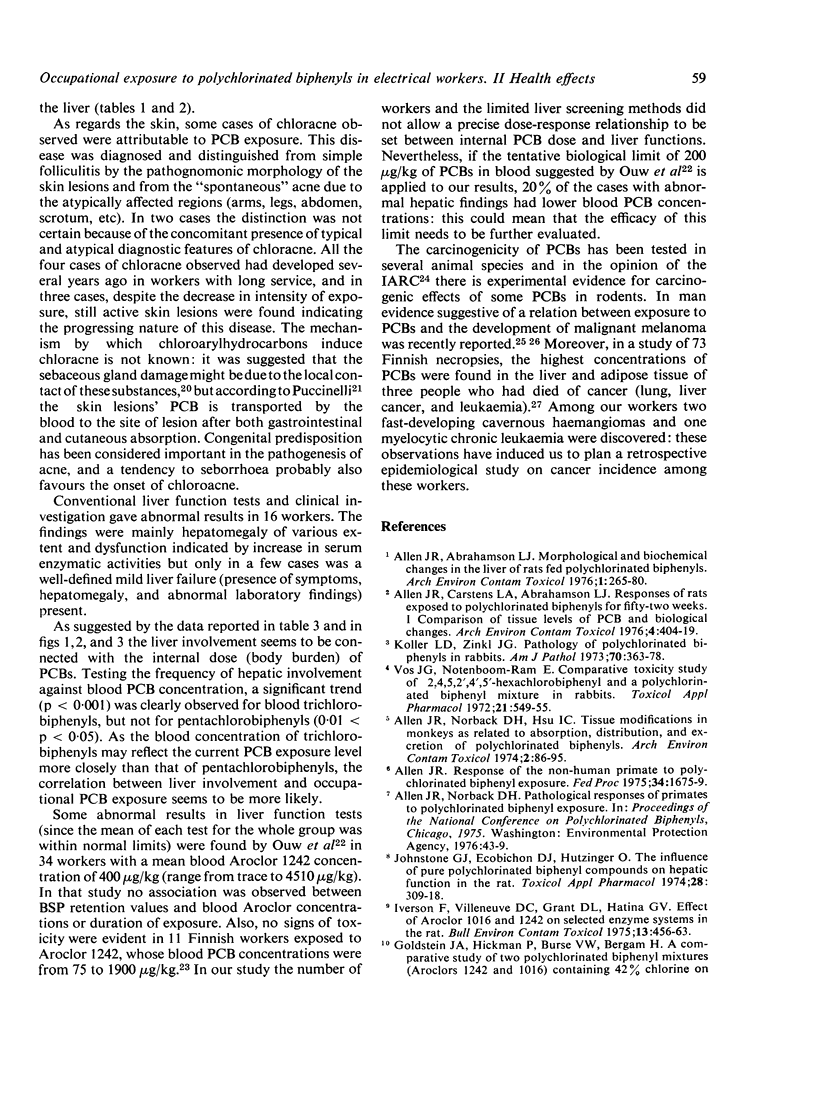Abstract
Health conditions were evaluated in 80 electrical workers exposed for many years to polychlorinated biphenyl (PCB) mixtures with a 42% mean chlorine content, who had blood PCB concentrations from 41 to 1319 micrograms/kg. The clinical study was based on personal history data, physical examination, and laboratory tests (red cell and leukocyte count; determination of haemoglobin, packed cell volume, bilirubin, serum protein electrophoretic fractions, pseudocholinesterase, AST, ALT, GGT, and OCT). Fifteen workers were found to have skin diseases--chloracne (4), folliculitis (4), oil dermatitis (1), juvenile acne (1), and dermatitis due to irritative or allergic agents (5). Sixteen workers showed more or less pronounced hepatic involvement, consisting most often of hepatomegaly with an increase in serum GGT, AST, ALT, and OCT values. In two workers bleeding cavernous haemangiomas were discovered, in one case associated with chronic myelocytic leukaemia. All the workers with chloracne were employed on electric capacitor impregnation with PCBs, and no definite association was found between chloracne and blood PCB concentrations. Conversely, a significant positive association was found between the abnormal liver findings and blood PCB concentrations, particularly trichlorobiphenyl blood concentrations. The abnormal hepatic findings observed are similar to those reported in experimental animals given PCBs, and in some workers such findings should probably be considered as clinical signs of hepatic microsomal enzyme induction.
Full text
PDF





Selected References
These references are in PubMed. This may not be the complete list of references from this article.
- Allen J. R., Abrahamson L. J. Morphological and biochemical changes in the liver of rats fed polychlorinated biphenyls. Arch Environ Contam Toxicol. 1973 Oct;1(3):265–280. doi: 10.1007/BF01985749. [DOI] [PubMed] [Google Scholar]
- Allen J. R., Carstens L. A., Abrahamson L. J. Responses of rats exposed to polychlorinated biphenyls for fifty-two weeks I. Comparison of tissue levels of PCB and biological changes. Arch Environ Contam Toxicol. 1976;4(4):404–419. doi: 10.1007/BF02221038. [DOI] [PubMed] [Google Scholar]
- Allen J. R., Norback D. H., Hsu I. C. Tissue modifications in monkeys as related to absorption, distribution, and excretion of polychlorinated biphenyls. Arch Environ Contam Toxicol. 1974 Mar;2(1):86–95. doi: 10.1007/BF01985803. [DOI] [PubMed] [Google Scholar]
- Allen J. R. Response of the nonhuman primate to polychlorinated biphenyl exposure. Fed Proc. 1975 Jul;34(8):1675–1679. [PubMed] [Google Scholar]
- Bahn A. K., Rosenwaike I., Hermann N., Grover P., Stellman J., O'Leary K. Letter: Melanoma after exposure to PCB's. N Engl J Med. 1976 Aug 19;295(8):450–450. doi: 10.1056/NEJM197608192950820. [DOI] [PubMed] [Google Scholar]
- Goldstein J. A., Hickman P., Jue D. L. Experimental hepatic porphyria induced by polychlorinated biphenyls. Toxicol Appl Pharmacol. 1974 Feb;27(2):437–448. doi: 10.1016/0041-008x(74)90215-4. [DOI] [PubMed] [Google Scholar]
- Goldstein J. A., McKinney J. D., Lucier G. W., Hickman P., Bergman H., Moore J. A. Toxicological assessment of hexachlorobiphenyl isomers and 2,3,7,8,-tetrachlorodibenzofuran in chicks. II. Effects on drug metabolism and porphyrin accumulation. Toxicol Appl Pharmacol. 1976 Apr;36(1):81–92. doi: 10.1016/0041-008x(76)90028-4. [DOI] [PubMed] [Google Scholar]
- Hattula M. L., Ikkala J., Isomäki M., Mättä K., Arstila A. U. Chlorinated hydrocarbon residues (PCB and DDT) in human liver, adipose tissue and brain in Finland. Acta Pharmacol Toxicol (Copenh) 1976;39(5):545–554. doi: 10.1111/j.1600-0773.1976.tb03204.x. [DOI] [PubMed] [Google Scholar]
- Iverson F., Villeneuve D. C., Grant D. L., Hatina G. V. Effect of aroclor 1016 and 1242 on enzyme systems in the rat. Bull Environ Contam Toxicol. 1975 Apr;13(4):456–463. doi: 10.1007/BF01721852. [DOI] [PubMed] [Google Scholar]
- Koller L. D., Zinkl J. G. Pathology of polychlorinated biphenyls in rabbits. Am J Pathol. 1973 Mar;70(3):363–378. [PMC free article] [PubMed] [Google Scholar]
- Lawrence C. PCB? and melanoma. N Engl J Med. 1977 Jan 13;296(2):108–108. doi: 10.1056/NEJM197701132960216. [DOI] [PubMed] [Google Scholar]
- Lincer J. L., Peakall D. B. Metabolic effects of polychlorinated biphenyls in the American kestrel. Nature. 1970 Nov 21;228(5273):783–784. doi: 10.1038/228783a0. [DOI] [PubMed] [Google Scholar]
- Ouw H. K., Simpson G. R., Siyali D. S. Use and health effects of Aroclor 1242, a polychlorinated biphenyl, in an electrical industry. Arch Environ Health. 1976 Jul-Aug;31(4):189–194. doi: 10.1080/00039896.1976.10667218. [DOI] [PubMed] [Google Scholar]
- PUCCINELLI V. Dell'acne clorica. Med Lav. 1954 Mar;45(3):131–145. [PubMed] [Google Scholar]
- Vos J. G., de Roij T. Immunosuppressive activity of a polychlorinated diphenyl preparation on the humoral immune response in guinea pigs. Toxicol Appl Pharmacol. 1972 Apr;21(4):549–555. doi: 10.1016/0041-008x(72)90011-7. [DOI] [PubMed] [Google Scholar]


